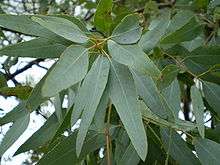Eucalyptus staigeriana
| Eucalyptus staigeriana | |
|---|---|
 | |
| Eucalyptus staigeriana leaf | |
| Scientific classification | |
| Kingdom: | Plantae |
| (unranked): | Angiosperms |
| (unranked): | Eudicots |
| (unranked): | Rosids |
| Order: | Myrtales |
| Family: | Myrtaceae |
| Genus: | Eucalyptus |
| Species: | E. staigeriana |
| Binomial name | |
| Eucalyptus staigeriana F. Muell. ex Bailey | |
Eucalyptus staigeriana, lemon ironbark or lemon-scented ironbark, is a small rough barked sclerophyll tree that grows naturally in pure stands on hills in the Palmer River region of Cape York, North Queensland, Australia.
Uses

The complex essential oil is distilled from the leaves and used for flavouring, perfumery and aromatherapy. It has a fruity-lemon fragrance with rosemary-like back tones. E. staigeriana fresh weight leaves yield 2.9-3.4% essential oil. It contains a range of essential oil components, including geranial, methyl geranate, geranyl acetate, limonene, phellandrene, neral, terpinolene and geraniol.
Brazil and Guatemala are the major producers of Eucalyptus staigeriana oil, with Brazil producing up to 60 tonnes pa.[1][2] Lemon ironbark is also grown in its country of origin in small-scale plantations in Queensland and Northern New South Wales, including for leaf as a bushfood spice.
The leaf is used in cooking like bay-leaf, and as an herbal tea ingredient in Australia. Lemon ironbark leaf has a high free radical scavenging ability.[3]
External links
References
- Boland et al., Eucalyptus Leaf Oils - Use, Chemistry, Distillation and Marketing, ISBN 0-909605-69-6.